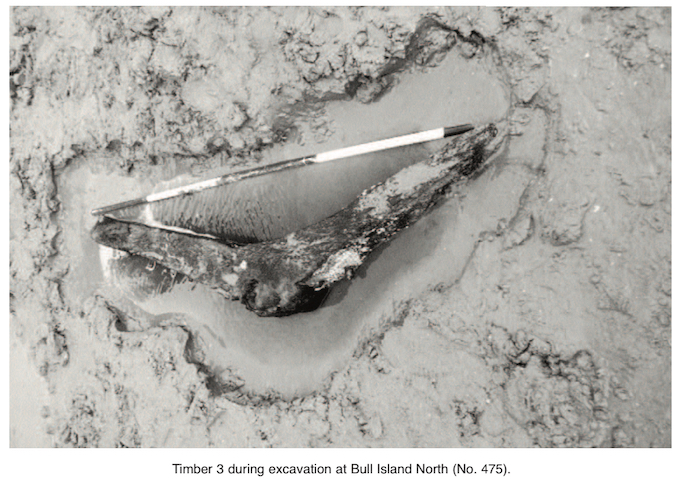County: Dublin Site name: BULL ISLAND NORTH, Bull Strand North
Sites and Monuments Record No.: N/A Licence number: 02E0158
Author: Karl Brady, Underwater Archaeology Unit, Dúchas: The Heritage Service
Site type: Wreck
Period/Dating: Modern (AD 1750-AD 2000)
ITM: E 720657m, N 737000m
Latitude, Longitude (decimal degrees): 53.369402, -6.186908
During an inspection of the shipwreck known as the Sutton Wreck on the North Bull Strand, a number of partially buried stray ship’s timbers were discovered on the beach. Recent storms and dredging operations in Dublin Bay appeared to have exposed the timbers, and they were subsequently washed ashore. It was necessary to excavate and remove the timbers for their safekeeping, as they were under threat of being washed away or damaged by beach traffic. The four timbers were excavated on 5 April 2002.
Timber 1 is an oak ship’s timber, possibly the first futtock of a framing piece. It is rectangular in section and heavily eroded at one end. It has six tree-nail holes along its length, with one tree nail still in situ, measuring 35mm in diameter. Some of the tree-nail holes have traces of iron concretion around them, suggesting iron fittings rather than tree nails. The timber is 1.9m long, 0.2m wide and 0.16m thick.
Timber 2 is an oak hull plank/strake. Its shape indicates that it comes from the fore or aft of a vessel. It is well preserved, with an elongated rectangular section, but the recent storms and dredging have caused some damage. It is badly cracked across its width near one end, and both ends show damage. A double row of tree-nail holes (21) runs the length of the strake, with thirteen tree nails still in situ. The tree nails are 35mm in diameter and have square pegs. Grooves or linear impressions are visible traversing the inner surface of the strake, indicating where framing may have abutted it. It is 2.42m long, 55mm thick and 0.26m wide.
Timber 3 is an oak floor timber. One end had been exposed underwater for some time before being washed ashore. It is badly worn and as a consequence is covered in barnacle and seaweed. The opposite end is worn but not as badly damaged. Fourteen of the fifteen tree nails (35mm in diameter) that run the length of the timber are still in situ and appear to have square pegs. Iron fittings would have originally attached the timber to the keel, as indicated by an area of iron concretion in the centre of the timber. At least ten iron nails (with square-sectioned shanks) and nail holes are also present on the timber. The timber also has two limber holes on its underside for drainage. Its size and the angle of the projecting arms indicate that it came from the fore or aft of a vessel. It is 2.18m long, with a maximum thickness of 0.22m and a maximum width of 0.22m.
Timber 4 is a small, badly worn oak piece of planking, broken at both ends with two worn tree nails in situ (35mm in diameter) It is partially gnawed at one end, probably the result of recent dredging operations in Dublin Bay. The timber is 0.67m long, 0.2m wide and 55mm thick.
Preliminary examination of the size and features of the timbers and their tree nails by Eachtra Archaeological Projects indicates that Timbers 1–3 are probably from the same vessel, most likely the Sutton Wreck.

Dún Scéine, Harcourt Lane, Dublin 2